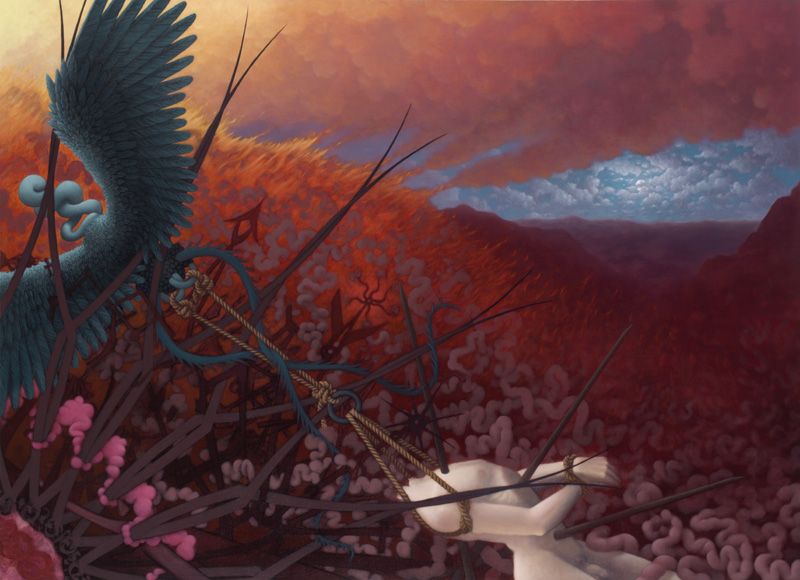
 |
| Apocalyptic Landscape 1990, acrylic on canvas 48 x 66 in. |
Apocalyptic Landscape |
Apocalyptic Landscape was painted during a transitional period between my early abstractions and subsequent representational work. In the transitional period I focused on incorporating a figure, or figures, into a world of abstract forms. In the painting I decided to also explore a more tangible and naturalistic space that contains a sky/ground plane relationship instead of my usual use of an amorphous ungrounded space. The overall feel of Apocalyptic Landscape is dramatic. In it I depict an imaginary, fantastical and disturbing landscape being consumed by fire. Flames shoot up from the mountain slopes sending billowing plumes of gold, red, and violet smoke that fill the night sky. Scattered across the terrain are a myriad violet and pink stylized intestines engulfed by the flames. In the foreground a giant blue winged creature is backlit by the gold and red glow of the blazing landscape. The creature has taken flight and is dragging a headless corpse through the tangled spokes of a giant wheel. It is a strange looking creature. Its head is made up of a twisted organic mass without a face; its feet are shaped like rings; and its tail is bifurcated, splined and extends far behind the creature's body. Attached to its ring-shaped feet are knotted ropes that angle down and intertwine around the tail until they end up tied to the arms and shoulders of the corpse. The corpse is seemingly the last and lone human victim shown in this horrific scene. Other victims are only hinted at through the grizzly remains of the intestines. His white-gray colored body stands in stark contrast against the darker landscape behind him. Looking closely, his hands are tied together in front of him and three long gray-metal spikes can be seen piercing his body as if some unknown force has skewered him. In the distance a valley can be seen nestled within a mountain range. The overhanging plumes of smoke cast an ominous shadow that blankets and darkens the entire valley. Above the distant mountain range a section of blue night sky, dotted with clouds illuminated by a full moon, peeks through beyond the smoke. The darkened valley and night sky create an atmosphere of tranquility, giving the viewer a needed reprieve to the havoc and horror exuded by the rest of the picture. |
 1990, acrylic on canvas 48 x 66 in. |
|
The general theme of Apocalyptic Landscape is change and transformation. This can be seen by the overall chaos and energy depicted in the painting. It is also reinforced by the use of elements such as fire, smoke, a wheel, the creature, and the corpse – all of which suggest destruction, movement and decay, and are all elements that change and transform the things around them. The painting also contains a sense of mystery that gives rise to questions like: What caused this fiery conflagration? Is the winged creature rescuing the corpse or taking him off to some hidden lair? Where did all the intestines come from? From other humans and/or animals? If so, what happened to them and where are their bodies? Apocalyptic Landscape captures the essence of an imaginary hell on earth. It evokes horrific visions of what could be. Given the self-destructive actions of humans toward both each other and the planet it is not inconceivable that apocalyptic nightmares similar to this can become a reality. - Brian Mains, June 2021 Addenda (June 27, 2021): Compositionally there are three aspects of the picture that are interesting to notice. The first is the dramatic difference in the spatial relationship of the elements in the picture. The wheel, winged creature, and corpse are elements that create visual interest in the foreground, whereas the transcendent moonlit sky and clouds create interest in the distance. The combination of the two heightens the spatial depth in the picture. The second is the placement of major elements in the corners of the picture. The winged creature is in the upper left; the moonlit sky and clouds are in the upper right; the hub of the giant wheel is in the lower left; and finally the corpse is in the lower right. The placement urges the viewer to look at one element after another thereby creating a greater dynamic in the painting. And lastly, the third is the tension caused by the opposing movement of two elements in the picture. Together the fire and smoke clouds move from left to right, whereas the winged creature dragging the corpse is in the opposite direction, from right to left. This tension also creates a greater dynamic in the painting. |